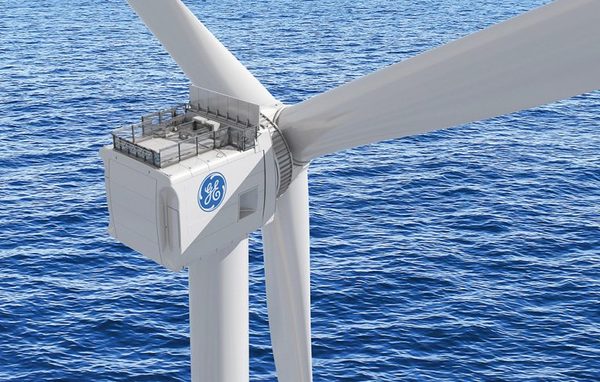News Release from GE Vernova
Wind Industry Profile of
The X Factor: Here’s What It Takes To Build The Tower For The World’s Most Powerful Offshore Wind Turbine
Castell and his team at GE Renewable Energy in Barcelona, Spain, and his team are designing a special tower for the Haliade-X 12 MW, the world’s most powerful offshore wind turbine. One 12-megawatt turbine will be capable of powering the equivalent of 16,000 European homes. Hundreds of them, sitting atop Castell’s towers, could soon dot the blustery coastlines of Europe and other continents, just beyond the horizon from beachgoers and tourists.
Built to work in waters as deep as 160 feet (50 meters), the steel structures will stretch as much as 720 feet (220 meters) tall from their heels buried in the seafloor to the top — depending on the location. Weighing in at 2,800 tons each — including the foundation, which is not designed by GE — these towers are more than capable of carrying the massive 12-megawatt generator and nacelle, and a record-breaking rotor that spans 722 feet (220 meters) in diameter, a distance longer than two Statues of Liberty standing on top of each other.
Flexing like a bow, the tower is designed to withstand gusts of wind pushing on the gargantuan rotor and tower from all angles, as well as tides buffeting the submerged structure.
The team is using a virtual model of the tower, its digital twin, and other computer models to forecast the effects from various forces the weather and water exert on the tower. “There are all kinds of forces at play,” Castell says. “Many times you will have the wind and the waves acting in the same direction, but often they are not. The models help us map the system so we know how it will behave.”
As if that weren’t enough, the designers must also account for the conditions of the seabed, where the tower foundation is anchored as deep as 131 feet (40 meters). “It’s quite demanding,” Castell says. “On the other hand, helping the world get more cleaner energy provides extra motivation.”
Castell has been designing wind turbines for a dozen years, but a tower of this size is pushing against the industry’s limits when it comes to transportation and installation. “The beauty of the [Haliade-X] is that there’s nothing out there rivaling it, not even close,” says Vincent Schellings, who leads the Haliade-X development team.

Today, the largest wind turbine has a rotor with a 590-foot diameter (180 meters), but that is a prototype. The biggest operating turbines have rotors topping 548 feet (167 meters) and generators rated up to 9.5 megawatts.
When the Haliade-X team decided to leapfrog the competition, they had to make sure they would be at the sweet spot, where size adds the most value. “If you go too big, you may generate more energy, but the tools and technology may not exist to transport and install your turbines in a cost-effective way,” Schellings says. “Potentially, your access to the market would be dramatically reduced.”
For example, the team relies on giant hammers to ram the turbine’s foundation, a huge upright steel tube called a monopile that itself weighs up to 2,000 tons, into the seabed. At 32 feet (10 meters) in diameter and walls as thick as 5 inches (12 centimeters), this is the maximum size existing hammers can handle when it comes to installing foundations. The same applies to the jack-up vessel cranes needed to install the blades, the nacelle (the structure that holds it all together, generator included) and the tower. “We are right at a point where we’re reaching the cranes’ limits,” Castell says.
Eiffel needed 18,000 steel pieces and 2.5 million rivets to build his tower. But Castell’s creation is a much more streamlined affair. The team designed the 800-ton segment that sits atop the monopile from many flat steel sheets properly bent to the right radius and welded together. Workers ship the entire 364-foot segment (111 meters) to the installation site by a special vessel and attach it to the foundation with huge bolts.
The team is also using the digital twin to design a “dynamic damper” at the top of the tower, a kind of controlled pendulum that allows them to counteract the harsh push and pull of nature’s forces at sea.
And once the turbines are operational, they will use the digital technology to monitor the turbines “at sea” and predict any potential erratic events early. That predictive ability can make a major difference by giving the team time to plan the service and keep the turbine operational.
Says Marc Sala, who leads the development effort for the Haliade-X: “For example, if you are able to detect and record the frequencies that describe how the tower is normally vibrating, you will be able to detect that something is changing.”
- Source:
- GE Reports
- Author:
- Tomas Kellner & Greg Petsche
- Link:
- www.ge.com/...
- Keywords:
- GE, report, Haliade, offshore, wind turbine, GE Renewable Energy


























